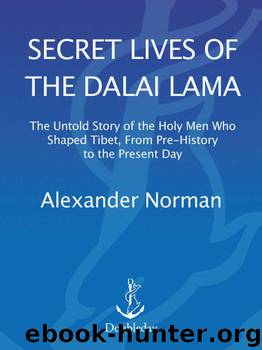Secret Lives of the Dalai Lama: The Untold Story of the Holy Men Who Shaped Tibet, from Pre-history to the Present Day by Norman Alexander

Author:Norman, Alexander [Norman, Alexander]
Language: eng
Format: azw3
ISBN: 9780385530712
Publisher: Random House, Inc.
Published: 2010-02-09T02:00:00+00:00
Accordingly, Lobsang Gyatso instructed Sonam Rabten to compose a letter to Gushri Khan authorizing an attack on the king of Beri, but requesting that his troops return to Mongolia directly thereafter.
Sonam Rabten, for his part, took a very different view of the matter. Clearly a political, if not a spiritual, visionary, he recognized in the king of Beri’s letter a casus belli that could propel the Gelug to preeminence throughout the whole of Tibet. He therefore disobeyed the Dalai Lama.
It was the custom of the day to accompany written communications with supplementary oral instructions. Where secrecy was paramount, these might entirely contradict the contents of the letter. Writing many years later, the Dalai Lama noted that, in this case, “the tune of the flute” seemed to have been transformed into “the song of the arrow.” Gushri Khan duly fell on Beri “like a red and black whirlwind” and the king was captured and executed during the closing weeks of 1640.8 The joyful news of his destruction reached Lhasa during the following Monlam Chenmo. It was especially well-received when it was further reported that the many monks imprisoned by the dharma-destroyer had also been freed. All Kham, as far east as Lijiang in modern-day Yunnan province (where hitherto the Kagyu had been the dominant sect), was now delivered to the followers of Tsongkhapa. But delight turned to consternation when rumors began to circulate that, following this success, Gushri Khan had not returned home as requested. Instead he was on the march to central Tibet. Telling Sonam Rabten that this time he had gone too far in his schemes, Lobsang Gyatso announced that he was determined to intervene. But it was too late. Even as they were discussing the matter, an urgent message arrived from Gushri. The Panchen Lama must immediately be summoned to safety as an attack on Tsang was imminent. Accordingly, Sonam Rabten drew up a letter containing the fiction that two of Gushri Khan’s wives had embarked on a pilgrimage to central Tibet.
The senior queen, having fallen ill, was unable to travel beyond Lhasa. The Panchen Lama should therefore come without delay. The elderly prelate duly set out, only to be turned back on the orders of the king of Tsang, who had in the meantime received word that the Mongol army was on its way. Mindful of the “Peace of Chakpori” negotiated by the Panchen Lama in 1621, the king urged him to intervene once more. But Sonam Rabten had already met with Gushri and led his army into Tsang. The Mongols were beyond recall.
Gushri Khan made directly for Shigatse, the capital of Tsang, meeting with little resistance en route. Sonam Rabten for his part—throwing off all pretense of neutrality—followed, taking over the administration of former Tsang strongholds as they fell. When they reached Shigatse itself, however, the Mongols found that the king had erected an impregnable stockade around the perimeter of his fortress, itself situated on a hill. Moreover, the accuracy of the Tsang archers prevented the Mongols from closing with the enemy.
Download
This site does not store any files on its server. We only index and link to content provided by other sites. Please contact the content providers to delete copyright contents if any and email us, we'll remove relevant links or contents immediately.
| African-American & Black | Australian |
| Chinese | Hispanic & Latino |
| Irish | Japanese |
| Jewish | Native American & Aboriginal |
| Scandinavian |
Becoming by Michelle Obama(9305)
The Last Black Unicorn by Tiffany Haddish(5085)
Beartown by Fredrik Backman(4447)
Man's Search for Meaning by Viktor Frankl(3657)
The Book of Joy by Dalai Lama(3243)
In a Sunburned Country by Bill Bryson(2957)
The Choice by Edith Eva Eger(2906)
The Five People You Meet in Heaven by Mitch Albom(2855)
Full Circle by Michael Palin(2786)
The Mamba Mentality by Kobe Bryant(2678)
The Social Psychology of Inequality by Unknown(2321)
Book of Life by Deborah Harkness(2286)
The Checklist Manifesto by Atul Gawande(2213)
Less by Andrew Sean Greer(2198)
The Big Twitch by Sean Dooley(2048)
No Room for Small Dreams by Shimon Peres(1994)
No Ashes in the Fire by Darnell L Moore(1987)
A Burst of Light by Audre Lorde(1985)
Imagine Me by Tahereh Mafi(1959)
